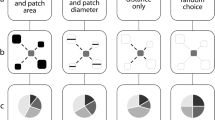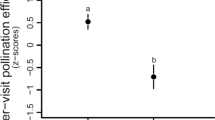Abstract
The portion-dilution model is a parametric restatement of the conventional view of animal pollination; it predicts the level of pollinator-mediated gene dispersal. In this study, the model was applied to white clover (Trifolium repens) and its most frequent pollinator, the honeybee (Apis mellifera). One of the three parameters in the portion-dilution model is the mean number of flowers a pollinator visits in one foraging bout. An alternative method to estimate this parameter was developed that was not depending on pollinator hive-seeking behaviour. The new estimation method, based on nectar collection, seems to be a good alternative, when reliable observation on visiting behaviour of pollinators is not possible. The gene flow in white clover was modelled. Where fields were assumed to be well separated, and only a low fraction of bees travelled between fields, the gene flow was estimated to be 0.7%, but subjected to large uncertainty. In a worst case scenario with adjacent fields—one with a genetically modified (GM) T. repens cultivar and the other with a conventional T. repens cultivar—and where all arriving bees were expected to transfer GM pollen, the median gene flow was modelled to be 7% with an estimated 95% percentile of 70%. The results show that the European Union threshold limit of 0.9% GM admixture for food and feed will likely be exceeded at times and especially organic farmers that do not accept GM admixture and often have clover and clover–grass fields might face challenges with admixture of GM.





Similar content being viewed by others
References
Andersen, E. S., Jespersgaard, P., & Østergaard, O. G. (1983). Databog Fysik Kemi. 2. edition. F&K Forlaget.
Braun, E., MacVicar, R. M., Gibson, D. A., Pankiw, P., & Guppy, J. (1953). Studies in red clover seed production. Canadian Journal of Agricultural Science, 31, 295–297.
Cecen, S., Gosterit, A., & Gurel, F. (2007). Pollination effects of the bumble bee and honey bee on white clover (Trifolium repens L.) seed production. Journal of Apicultural Research, 46, 69–72.
Cresswell, J. E. (2005). Accurate theoretical prediction of pollinator-mediated gene dispersal. Ecology, 86, 574–578.
Cresswell, J. E. (2008). Estimating the potential for bee-mediated gene flow in genetically modified crops. In R. R. James & T. L. Pitt-Singer (Eds.), Bee pollination in agricultural ecosystems (pp. 184–202). Oxford: Oxford University Press.
Cresswell, J. E., & Hoyle, M. (2006). A mathematical method for estimating patterns of flower-to-flower gene dispersal from a simple field experiment. Functional Ecology, 20, 245–251.
Cresswell, J. E., Bassom, A. P., Bell, S. A., Collins, S. J., & Kelly, T. B. (1995). Predicted pollen dispersal by honey-bees and three species of bumble-bees on oil-seed rape: a comparison of three models. Functional Ecology, 9, 829–841.
Cresswell, J. E., Osborne, J. L., & Bell, S. A. (2002). A model of pollinator-mediated gene flow between plant populations with numerical solutions for bumblebees pollinating oilseed rape. Oikos, 98, 375–384.
Damgaard, C., Simonsen, V., & Osborne, J. L. (2008). Prediction of pollen-mediated gene flow between fields of red clover (Trifolium pratense). Enviromental Modeling & Assessment, 13, 483–490.
Goulson, D. (2000). Why do pollinators visit proportionally fewer flowers in large patches? Oikos, 91, 485–492.
Hammer, O. (1963). Om træk i hvidkløver, der blomstrer samtidig med vårraps. Tidsskrift for biavl, 97, 191–193.
Holm, S. N. (1982). Insektbestøvning af kulturplanter. Afdelingen for landbrugets plantekultur (KVL.)
Marshall, A., Michaelson-Yeates, T., & Williams, I. (1999). How busy are bees—modeling the pollination of clover. Iger innovations, 1999, 18–21. http://www.aber.ac.uk/en/media/99ch3.pdf
Palisade Europe. http://www.palisade-europe.com
Percival, M. (1950). Pollen presentation and pollen collection. Phytologist, 49, 40–63.
Pilson, D., & Prendeville, H. R. (2004). Ecological effects of transgenic crops and the escape of transgenes into wild populations. Annual Review of Ecology, Evolution, and Systematics, 35, 149–174.
Tolstrup, K., Andersen, S. B., Boelt, B., Buus, M., Gylling, M., Holm, P. B., et al. (2003). Rapport fra Udredningsgruppen vedrørende sameksistens mellem genetisk modificerede, konventionelle og økologiske afgrøder. Ministeriet for fødevarer, landbrug og fiskeri.
Tolstrup, K., Andersen, S. B., Boelt, B., Buus, M., Gylling, M., Holm, P. B., et al. (2007). Supplerende rapport fra Udrednings-gruppen vedrørende sameksistens mellem genetisk modificerede, konventionelle og økologiske afgrøder. Ministeriet for fødevarer, landbrug og fiskeri.
Weaver, N. (1965). Foraging behavior of honeybees on white clover. Insectes Sociaux, XII(3), 231–240.
Yearly report (2009). Danish seed producers trade organisation, http://www.brancheudvalgetforfroe.dk/getMedia.asp?mb_GUID=332A0DC0-E3F7-4D94-961A-0AA4CB97CCA7.pdf
Acknowledgements
The authors wish to thank Vibeke Meyer (DLF-Trifolium) for providing us with the plant material. A special thanks to Per Kristiansen (DJF, AU) for generously providing us with honeybee hives. Annie Enkegaard (DJF, AU) is thanked for generously lending us her research material on nectar production in white clover. We are also grateful to Mads Andersen who gave us permission to perform pollinator observations in his organic clover field in Torkildstrup. Finally, we acknowledge the wise words about bees from Winnie the Pooh. This project was funded by FØJO III.
Author information
Authors and Affiliations
Corresponding author
Rights and permissions
About this article
Cite this article
Løjtnant, C.L., Boelt, B., Clausen, S.K. et al. Modelling Gene Flow between Fields of White Clover with Honeybees as Pollen Vectors. Environ Model Assess 17, 421–430 (2012). https://doi.org/10.1007/s10666-011-9303-1
Received:
Accepted:
Published:
Issue Date:
DOI: https://doi.org/10.1007/s10666-011-9303-1




